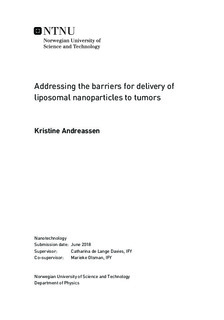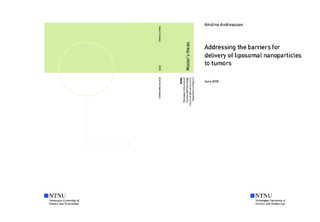| dc.description.abstract | This study concerns the enhanced delivery of three types of fluorescently labelled liposomal nanoparticles to prostate cancer xenographs. Passive delivery of the liposomes was achieved by utilizing the enhanced permeability and retention effect within tumors, while active delivery was achieved by introducing microbubbles along with the liposomal nanoparticles and applying ultrasound locally to the tumor tissue. Cavitation of the microbubbles will induce stress on the blood vessel walls, which increases their permeability. Ultrasound can also cause local streaming of interstitial liquid and thereby increase penetration of nanoparticles into tumor tissue. In this study, four barriers to drug delivery was addressed by studying the aggregation behaviour of the NPs, their extravasation and distribution in tumor tissue with and without exposure to ultrasound and microbubbles, and their cellular uptake in vitro. Poly(ethylene glycol) is attached to all three types of liposomal nanoparticles to increase their stealth.
For all three formulations the fluorescence emission spectra were captured and assessed. Aggregation behaviour of the NPs when mixed with whole blood and serum was investigated by confocal microscopy. The research was concerned with animal experiments on mice (all animal experiments were performed by Ph.D. candidate Marieke Olsman). Tumor tissue samples from the animal experiments were imaged by confocal and multiphoton microscopy by the author, and image analysis was performed to evaluate the effect of ultrasound on the extravasation of nanoparticles and distance travelled from the blood vessel wall. In addition, in vitro cellular uptake of the three nanoparticles was investigated using flow cytometry, supported by confocal microscopy. The behaviour of the three liposomal nanoparticles when mixed with whole blood and serum was investigated by confocal microscopy.
Applying ultrasound was found to minimally increase extravasation of all three nanoparticles for both mechanical indices, with the exception of one low ultrasound intensity group. A large mean distance travelled from blood vessels was obtained when the extravasation was relatively high. A large degree of heterogeneity was seen between and within animals, making it challenging to evaluate whether the observed effects were truly due to ultrasound exposure. There was no clear aggregation behaviour of the nanoparticles observed when added to blood and serum, but more aggregates were observed in the stock solution of the standard nanoparticles, compared to the other two nanoparticles. The standard formulation of nanoparticles were taken up in cells much more frequently than the cleavable and non-cleavable formulations of nanoparticles. Removing of the poly(ethylene glycol) did not affect the cellular uptake in vitro. | |

